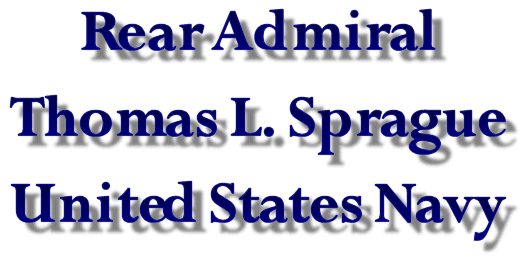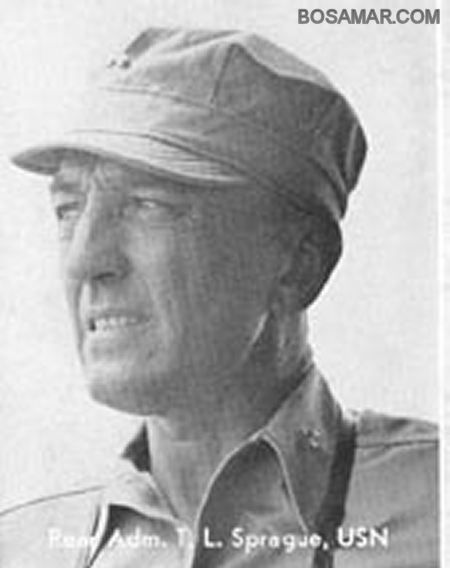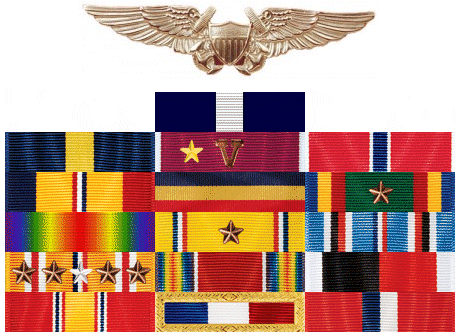
Commander Task Group 77.4
Commander Carrier Division 22
Commander Task Unit 77.4.1 (Taffy I)

U.S. Navy photograph
Rear Admiral Thomas L. Sprague, U.S. Navy

| Navy Cross | |
| Navy Distinguished Service Medal | |
| Legion of Merit (2) w/Combat "V" | |
| Bronze Star | |
| Combat Action Ribbon | |
| Presidential Unit Citation | |
| Navy Unit Commendation (2) | |
| WW1 Victory Medal w/Destroyer Clasp | |
| American Defense Service Medal (2) | |
| American Campaign Medal | |
| Asiatic-Pacific Campaign Medal (10) | |
| World War II Victory Medal | |
| National Defense Service Medal | |
| Philippine Presidential Unit Citation | |
| Philippine Liberation Medal | |
| Award Criteria | |
| RANK | DATES | DUTY STATION/EVENT |
| - | 1894 | Born in Lima, Ohio |
| MIDN | 1914-1917 | Student at U.S. Naval Academy Annapolis |
| ENS | 1917-1918 | USS Cleveland (C-19) |
| ENS | 1918 | Sixth Naval District, headquarters, Charleston, South Carolina |
| ENS | 1918-1920 | Engineer & CO, USS Montgomery (DD-121) |
| LTJG | 1920 | Naval Aviation Preflight Indoctrination, NAS Pensacola, Florida |
| LTJG | 1920-1921 | Naval Flight Training, NAS Pensacola, Florida |
| LT | 1921-1922 | Staff of Commander Aircraft, Pacific Fleet |
| LT | 1922-1923 | Aircraft Squadron SPOT 4 in USS Aroostock (CM-3) |
| LT | 1923-1926 | Naval Air Station Pensacola |
| LT | 1926 | Observation Squadron VO-1 in USS Langley (CV-1) |
| LT | 1927-1928 | Aviation Unit in USS Maryland (BB-46) |
| LT | 1928-1931 | Naval Air Station, San Diego, California |
| LT | 1931-1932 | CO, Scouting Squadron VS-6 & Aide to Commander Cruiser Division THREE in USS Concord (CL-10) |
| LCDR | 1932 | CO, Scouting Squadron VS-10 attached to Cruiser Division FIVE with additional duty as Commander Cruiser Wing of Cruiser Command, US Fleet, & on the staff of Commander Cruisers, US Fleet |
| LCDR | 1933-1934 | Naval Aircraft Factory, Philadelphia, Pennsylvania |
| LCDR | 1935-1936 | Air Officer, USS Saratoga (CV-3) |
| LCDR | 1936-1937 | Navigator, USS Langley (CV-1) |
| LCDR | 1937-1940 | Superintendant of Aviation Training, Naval Air Station, Pensacola, Florida |
| CDR | 1940-1941 | XO, USS Ranger (CV-4) |
| CDR | 1941 | CO, USS Pocomcke (AV-9) |
| CDR | 1941-1942 | CO, USS Charger (CVE-30) |
| CAPT | 1942-1943 | Chief of Staff and Aide to Commander Fleet Air, Quonset, Quonset Point, Rhode Island, and to Commander Air Force, Atlantic Fleet |
| CAPT | 1943-1944 | CO, USS Intrepid (CV-11) |
| CAPT | 1944 | Commander Fleet Air, Alameda (California) |
| RADM | 1944 | CTG 77.4/COMCARDIV 22 with flag in USS Sangamon (CVE-26) at Saipan |
| RADM | 1944 | CTG 77.1/COMCARDIV 22 with flag in USS Sangamon (CVE-26) at Morotai |
| RADM | 1944 | CTG 77.4/COMCARDIV 22 with flag in USS Sangamon (CVE-26) at Samar |
| RADM | 1945 | COMCARDIV 11 (Training Carriers) |
| RADM | 1945 | COMCARDIV 3 & TG 38.1 in USS Hancock (CV-19) and USS Wasp (CV-18) at Okinawa |
| RADM | 1946-1947 | Deputy Chief of Naval Personnel (BUPERS) |
| RADM | 1947-1949 | Chief of the Bureau of Naval Personnel |
| RADM | 1949-1952 | Commander, Naval Air Pacific & with additional duty as Commander First Task Fleet, San Diego, California |
| VADM | 1952 | Retired from Service |
| - | 1972 | Died |
Short biography of
Vice Admiral Thomas Lamison Sprague, U.S. Navy
Thomas Lamison Sprague was born on October 2, 1894 in Lima, Ohio, the son of Grant Madison Sprague and Olivia Lamison Sprague, both of pre-Revolutionary stock. He is the eleventh generation of male descendants of William Sprague who settled in Massachusetts in 1628 from Dorsetshire England. He attended public schools in Lima and the Ohio State University, at Columbus, before his appointment to the US Naval Academy, Annapolis, Maryland, from the Fourth District of Ohio in 1914.
He graduated from the United States Naval Academy in Annapolis, Maryland on June 29, 1917 with the Class of 1918. Although no relation to Admiral Clifton "Ziggy" Sprague, the two both attended Annapolis, both later graduating from the same class. After graduation from the Naval Academy in June 1917, he was assigned to the USS Cleveland (C-19), which operated on patrol and convoy service during World War One. In April 1918 he reported for duty in connection with the training of officers and men of the Navy and Naval Reserve at receiving ships, camps and schools in the Sixth Naval District, headquarters at Charleston, South Carolina. He was detached in July of that year to assist in fitting out the USS Montgomery (DD-121) at the Newport News Shipbuilding and Drydock Company, Newport News, Virginia, and was Engineer of that destroyer from her commissioning, 26 July 1918, until 1 January 1920, when he became her Commanding Officer.
Detached from the Montgomery in November 1920, he reported to the Naval Air Station, Pensacola, Florida, for flight training, and was designated Naval Aviator on 11 August 1921. Serving briefly at the Naval Air Station, Anacostia, DC, he reported in November, that year, for duty on the Staff of Commander Aircraft, Pacific Fleet (later redesignated Commander Aircraft Squadrons, Battle Force). In 1922 he was assigned to Aircraft Squadron SPOT 4 (attached to the aircraft tender Aroostock (CM-3), an airplane tender), which later became Observation Squadron 2 before his detachment in June 1923.
For three years he had duty at the Naval Air Station, Pensacola, and in July 1926 reported to Aircraft Squadrons, Battle Fleet, serving with Observation Squadron ONE, based on the aircraft carrier Langley, and later with the aviation unit of the USS Maryland (BB-46). Detached from the latter in July 1928, he had a three year tour of duty at the Naval Air Station San Diego, California. In July 1931 he assumed command of Scouting Squadron 6, and while so serving had additional duty as Aide to Commander Cruiser Division THREE, the USS Concord (CL-10), flagship. In June 1932 he was transferred to command of Scouting Squadron 10, attached to Cruiser Division FIVE, with additional duty as Commander of the Cruiser Wing of the Cruiser Command, US Fleet, and on the staff of Commander Cruisers, US Fleet.
Duty as Superintendant of the Aeronautical Engine Laboratory, Naval Aircraft Factory, Philadelphia, Pennsylvania, preceded a year's duty as Air Officer of the USS Saratoga (CV-3), and a second year as Navigator of the USS Langley (CV-1). In June 1937 he returned to the Naval Air Station, Pensacola, where he served for three years as Superintendant of Aviation Training. He was again ordered to sea, and from June 1940 until July 1941 served as Executive Officer of the USS Ranger (CV-4). He assisted in the conversion of the USS Pocomcke (AV-9), and was commanding that vessel at the outbreak of World War II.
He next fitted out and placed in commission the USS Charger (CVE-30), second escort carrier to be commissioned, on 3 March 1942. He commanded the Charger until December 1942, then served successively as Chief of Staff and Aide to Commander Fleet Air, Quonset, at Quonset Point, Rhode Island, and to Commander Air Force, Atlantic Fleet. 'For exceptionally meritorious service in support of sustained operations against the enemy while serving as Chief of Staff to Commander Patrol Wings, US Atlantic Fleet, and later as Aide and Chief of Staff to Commander Air Force, US Atlantic Fleet, from April 1942 until June 1943 where he was awarded the Bronze Star Medal.
After fitting out the USS Intrepid (CV-11) at the Newport News Shipbuilding and Drydock Company, he commanded that aircraft carrier from her commissioning, 16 August 1943, until March 1944. Under his command, the Intrepid participated in the campaign leading up to the capture of the Marshall Islands and the first carrier attacks on Truk Atoll. During the night after the first raid, she was attacked by night flying Japanese torpedo planes and struck by a torpedo, the explosion jamming her rudder and destroying the steering engines and flooding the after end of the ship. He ordered a sail rigged to assist in steering control, headed the ship clear of the battle area and returned the Intrepid 6000 miles to San Francisco for repairs. He was awarded the Legion of Merit 'For exceptionally meritorious conduct... during the attack on Truk Atoll in the Caroline Islands on February 16-17, 1944...(when) under the skillful leadership of Captain Sprague, the damage was brought under control and the ship returned to a safe port under her own power...'
Returning to the United States in March 1944, he had brief duty as Commander Fleet Air, Alameda (California), and in July assumed command of Carrier Division 22. That division, under his command, took part in the capture of Saipan and Guam in the Marianas and of Morotai in the New Guinea Campaign. During the following October, in the initial assault phase of the invasion of Leyte, Philippine Islands, units under his command furnished strategical and direct support to the successful Leyte landings of troops by conducting anti-submarine and combat air patrols. He was awarded a Gold Star in lieu of the Second Legion of Merit 'For distinguishing himself by exceptionally meritorious conduct...as Commander Task Group 77.4 and the Escort Carrier Task Group...in the planning of the largest amphibious operation undertaken in the Southwest Pacific Area, the invasion of Leyte on 20 October 1944...' Sprague was in command of the eighteen escort carriers of Task Group 77.4 ("Taffy 1") and Carrier Division 22 during the Battle of Leyte Gulf in October 1944. His extraordinary heroism in action on October 25, 1944 in the Battle Off Samar would earn him the Navy Cross. Admiral Sprague is also entitled to the Presidential Unit Citation, awarded the officers and men of the USS Sangamon (CVE-26), his flagship during the Philippine operations.
When detached from command of Carrier Division 22, he assumed command of Carrier Division 3 and Task Group 38.1, which engaged in fast carrier pre-invasion operations against the Japanese homeland until the enemy's capitulation in August 1945. For brilliant service in that command, he was awarded the Distinguished Service Medal.
He flew his flag, as Commander Carrier Division 3, in the USS Hancock (CV-19), and in the USS Wasp (CV-18) during part of the period from 10 October 1944 to 15 August 1945, and each carrier was awarded the Navy Unit Commendation. After his return to the United States he reported on 10 January 1946, as Deputy Chief of Naval Personnel, Navy Department, Washington DC. On 22 February 1947, he became Chief of the Bureau of Naval Personnel, and served in that capacity until September 1949, and in October assumed command of Air Force, Pacific Fleet. He was later assigned additional duty as Commander First Task Fleet, with Headquarters at San Diego, California. He was relieved of all active duty, and transferred to the Retired List on 1 April 1952.
In addition to the Navy Cross, the Distinguished Service Medal, the Legion of Merit with Gold Star and Combat 'V,' the Bronze Star Medal, Presidential Unit Citation Ribbon (Sangamon), and the Navy Unit Commendation Ribbon (Hancock and Wasp), Admiral Sprague has the Victory Medal, Destroyer Clasp (World War I); the American Defense Service Medal with bronze 'A'; American Campaign Medal; Asiatic-Pacific Campaign Medal with one silver and four bronze stars (ten engagements); the World War II Victory Medal; Navy Occupation Service Medal, Asia Clasp; and the Philippine Liberation Ribbon with two bronze stars.
Sprague briefly returned to active duty to negotiate with the Philippine government over the status of U.S. air bases in 1956.
Vice Admiral Sprague died in California on September 17, 1972.
Source: Navy Biographies Branch, OI-450, March 29, 1957 and Robert Jon Cox independent research